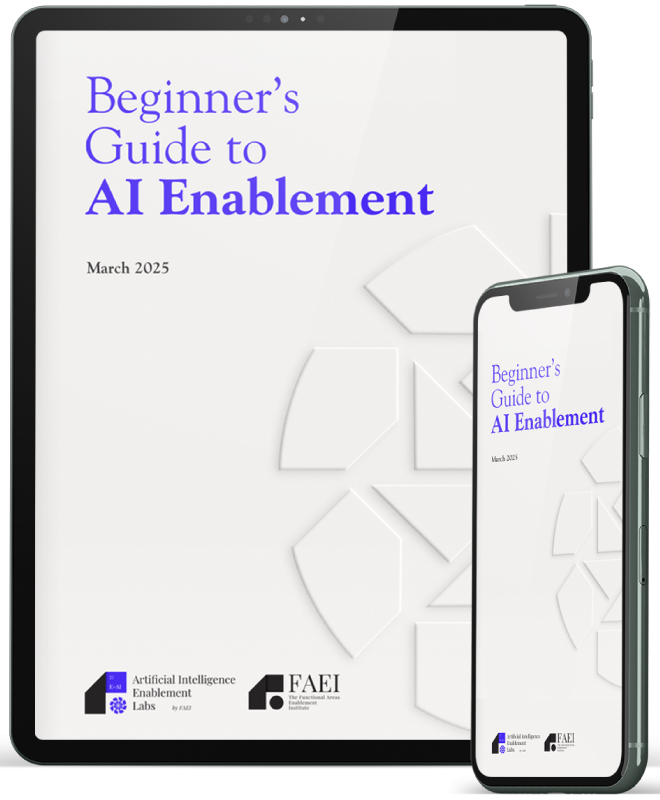
In a world where operational efficiency can make or break an organization, mastering the art of Functional Area Enablement (FAE) is no longer optional—it’s essential. The ability to align and optimize every department’s performance can unlock unparalleled productivity and success.
Why is this critical? Today’s businesses face increasing complexity, with evolving functions, new processes, and vast documentation. Without a structured approach, inefficiencies arise, and opportunities are lost. Functional Area Enablement addresses this challenge head-on, bridging gaps and providing actionable solutions. This article explores what Functional Area Enablement is, why it’s vital, and the framework behind it.
Continue reading to discover how you can leverage FAE to transform your organization.
Functional Area Enablement focuses on aligning and streamlining organizational functions through a structured framework. It bridges the gap between academic research and practical application, ensuring that every department operates with standardized yet customizable processes. By doing so, FAE fosters collaboration, reduces redundancies, and drives better decision-making.
Organizations today face increasing complexity due to evolving functional areas, new processes, and extensive documentation. This complexity often results in inconsistent practices, inefficiencies, and limited visibility into performance. Functional Area Enablement provides a solution by establishing a standardized management framework that promotes operational efficiency, improved consistency, better visibility into performance, informed decision-making, and reduced duplication of efforts. FAE ensures that all areas of the organization work harmoniously toward shared goals.
The Functional Area Enablement Lab is built upon a robust framework comprising 10 clusters and 136 elements. These clusters represent key functional areas within an organization, ensuring comprehensive and holistic management. Below is an exploration of each cluster:
Identity
The Identity cluster focuses on defining and managing the core services and functions of the organization. Domains like Service Management and Marketing ensure that the organization’s offerings are clearly articulated and effectively delivered. By strengthening the foundation, this cluster helps organizations build a strong identity and maintain a competitive edge.
Context
The Context cluster emphasizes understanding both internal and external environments. Domains such as Internal Intelligence, External Intelligence, and Data Governance provide tools to analyze data, monitor trends, and ensure data integrity. This cluster enables organizations to make informed decisions based on a comprehensive understanding of their operating environment.
Strategy
Strategy is central to achieving long-term goals. This cluster includes domains like Development Roadmap and Innovation, which guide organizations in planning and executing transformative initiatives. By fostering creativity and setting clear objectives, the Strategy cluster drives sustainable growth and adaptability.
Administration Performance
This cluster focuses on measuring and managing performance. Domains like Performance Management and Performance Measurement ensure that organizations have the tools to monitor progress, identify areas for improvement, and achieve desired outcomes. Effective administration performance is essential for maintaining accountability and driving results.
Implementation
The Implementation cluster ensures that strategies are effectively executed. Domains such as Governance, Operations, and HSSE (Health, Safety, Security, and Environment) provide the necessary frameworks to operationalize plans and maintain compliance. This cluster helps organizations turn strategic visions into tangible outcomes.
Investment
The Investment cluster manages resources to support organizational goals. Domains like Finance, Information Technology, Procurement, and Logistics ensure that resources are allocated efficiently and that investments yield maximum returns. By focusing on resource optimization, this cluster drives financial sustainability and operational effectiveness.
Talent
The Talent cluster is dedicated to workforce management and development. Domains like Human Resources Administration and Employee Performance emphasize attracting, retaining, and nurturing talent. This cluster ensures that employees are equipped to perform at their best, fostering a culture of continuous improvement.
Enablement
Enablement focuses on equipping teams with the tools and processes needed for success. Domains such as Project Management, Process Management, and Risk Management provide the frameworks for executing projects, refining workflows, and mitigating risks. This cluster empowers teams to achieve their goals efficiently.
Engagement
Engagement prioritizes building relationships with key stakeholders. Domains like Sales, Customer Service, and Stakeholder Management ensure that organizations effectively connect with their audiences, address their needs, and foster loyalty. Strong engagement drives customer satisfaction and long-term partnerships.
Evaluation
Evaluation ensures that organizational practices are continuously assessed and improved. Domains like Internal Audit and Sustainability provide mechanisms for reviewing performance, ensuring compliance, and promoting environmental and social responsibility. This cluster helps organizations remain accountable and forward-thinking.
Functional Area Enablement provides a comprehensive framework for optimizing every department within an organization. By addressing challenges with structured solutions, it enhances efficiency, collaboration, and overall performance.

You’re about to join a network of forward-thinking professionals committed to elevating business functions through collaboration, innovation, and shared expertise. Fill out the form to access members-only tools, early updates, and valuable connections across every functional area.
You’re about to join a network of forward-thinking professionals committed to elevating business functions through collaboration, innovation, and shared expertise. Fill out the form to access members-only tools, early updates, and valuable connections across every functional area.
You’re about to join a network of forward-thinking professionals committed to elevating business functions through collaboration, innovation, and shared expertise. Fill out the form to access members-only tools, early updates, and valuable connections across every functional area.
You’re about to join a network of forward-thinking professionals committed to elevating business functions through collaboration, innovation, and shared expertise. Fill out the form to access members-only tools, early updates, and valuable connections across every functional area.
You’re about to join a network of forward-thinking professionals committed to elevating business functions through collaboration, innovation, and shared expertise. Fill out the form to access members-only tools, early updates, and valuable connections across every functional area.
You’re about to join a network of forward-thinking professionals committed to elevating business functions through collaboration, innovation, and shared expertise. Fill out the form to access members-only tools, early updates, and valuable connections across every functional area.
